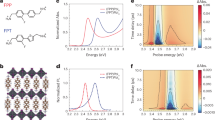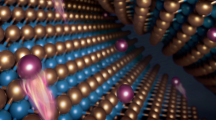Abstract
IN 1914 Jevons1 made measurements on a band spectrum which he attributed to boron nitride. He correlated most of the bands into two systems (“” and “”); a number of weaker bands remained. Recent investigation by the writer2 shows that the spectrum—which is probably due to the compound BO—really consists of two superposed spectra.3 These are related to each other exactly as would be predicted by the quantum theory of band spectra if the more intense spectrum is due to the more abundant isotope B11O, and the less intense to the less abundant isotope B10O. Every one of the approximately 80 bands of B11O, including those both of the and of the systems, is matched, so far as can be determined4, by a corresponding B10O band of about the expected intensity.5 In each system, the central band, corresponding to an electronic change alone in a vibrationless molecule, is practically coincident for the two isotopes.6 From this centre the bands extend both toward lower and toward higher frequencies, the pattern being exactly the same for both isotopes, the scale or spacing of this pattern, however, being larger for the lighter isotope in a ratio approximately equal to the ratio of the molecular vibration frequencies. This is exactly as predicted by the quantum theory. The maximum separation between corresponding bands of the two isotopes is more than 300 wavenumber units in each system (this amounts to about 200 Å. U. near 8500 in the system).
This is a preview of subscription content, access via your institution
Access options
Subscribe to this journal
Receive 51 print issues and online access
$199.00 per year
only $3.90 per issue
Buy this article
- Purchase on Springer Link
- Instant access to full article PDF
Prices may be subject to local taxes which are calculated during checkout
Similar content being viewed by others
Author information
Authors and Affiliations
Rights and permissions
About this article
Cite this article
MULLIKEN, R. Isotope Effects in the Band Spectra of Boron Monoxide and Silicon Nitride. Nature 113, 423–424 (1924). https://doi.org/10.1038/113423a0
Issue Date:
DOI: https://doi.org/10.1038/113423a0
This article is cited by
-
The cosmological constant and the pulsating universe
Il Nuovo Cimento B (1991)
Comments
By submitting a comment you agree to abide by our Terms and Community Guidelines. If you find something abusive or that does not comply with our terms or guidelines please flag it as inappropriate.



